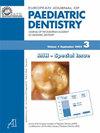Environmental risk factors analysis in paediatric oral health: a cross-sectional study.
IF 2.2
2区 医学
Q2 DENTISTRY, ORAL SURGERY & MEDICINE
引用次数: 0
Abstract
AIM The aim of the present study was to evaluate the association between environmental risk factors [adherence to the Mediterranean diet (MD), eating habits, hygiene habits, body mass index (BMI)] with the presence of caries in a university-based cohort of paediatric patients. MATERIALS A total of 118 paediatric patients were included in the study. In addition to the evaluation of clinical (vitality test, percussion test) and radiographic (X-ray bitewing, OPT) parameters, patients' lifestyle was investigated through validated questionnaries. Data regarding decayed, missing, filled teeth index were recorded for both permanent (DMFT) and deciduous teeth (dmft). Logistic/linear regression models (crude estimates) and multiple regression models (logistic/linear) adjusted for confounding factors were built to evaluate the association between lifestyle habits and caries. The results were reported as Odds Ratio (OR - con 95% CI) for logistic regression models and Mean Difference (MD - con 95% CI) for linear models. CONCLUSION The present study confirmed the role of nutritional habits in caries development in the paediatric population, especially for deciduous dentition. Further clinical studies are needed to improve the quality of administered questionnaires and evaluate the cause/effect relationship between environmental risk factors and caries.儿科口腔健康的环境风险因素分析:一项横断面研究。
本研究旨在评估环境风险因素(地中海饮食习惯、饮食习惯、卫生习惯、体重指数(BMI))与大学儿科患者龋齿之间的关系。除了评估临床(活力测试、叩诊测试)和放射学(X 光咬合、OPT)参数外,还通过经过验证的问卷调查了患者的生活方式。记录了恒牙(DMFT)和乳牙(dmft)的蛀牙、缺失、补牙指数数据。为评估生活习惯与龋齿之间的关系,建立了逻辑/线性回归模型(粗略估计)和经混杂因素调整的多元回归模型(逻辑/线性)。本研究证实了营养习惯在儿童龋齿发展中的作用,尤其是在乳牙阶段。需要进一步开展临床研究,以提高问卷调查的质量,并评估环境风险因素与龋齿之间的因果关系。
本文章由计算机程序翻译,如有差异,请以英文原文为准。
求助全文
约1分钟内获得全文
求助全文
来源期刊

European journal of paediatric dentistry
DENTISTRY, ORAL SURGERY & MEDICINE-PEDIATRICS
CiteScore
4.60
自引率
19.40%
发文量
43
审稿时长
6-12 weeks
期刊介绍:
The aim and scope of the European Journal of Paediatric Dentistry is to promote research in all aspects of dentistry related to children, including interceptive orthodontics and studies on children and young adults with special needs.
 求助内容:
求助内容: 应助结果提醒方式:
应助结果提醒方式:


